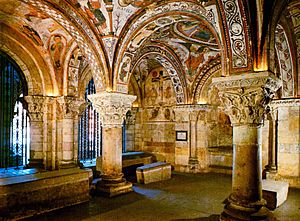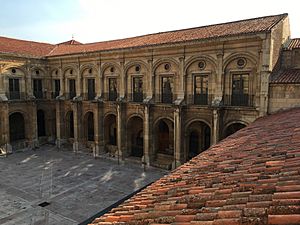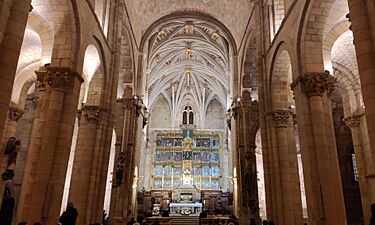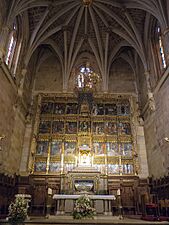San Isidoro, León facts for kids
Quick facts for kids St. Isidore's Basilica |
|
|---|---|
| Real Colegiata Basílica de San Isidoro | |
|
Basílica de San Isidoro
|
|
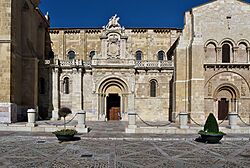
South façade
|
|
| Location | León, Castile and León |
| Country | Spain |
| Denomination | Catholic Church |
| History | |
| Status | Minor basilica |
| Founded | 10th century |
| Dedication | Isidore of Seville |
| Architecture | |
| Style | Romanesque |
| Years built | 11th–12th century |
| Administration | |
| Archdiocese | Oviedo |
| Diocese | León |
The St. Isidore's Basilica (Spanish: Basílica de San Isidoro) is a special Catholic church in León, Spain. It stands where an old Roman temple once was. This church has been a Christian site since the early 900s. Back then, it was a monastery dedicated to Saint John the Baptist.
In 1063, the church was renamed to honor Saint Isidore of Seville. Isidore was a very important religious leader and scholar from Seville. His remains were brought to León so they could rest in Christian land. Many people still visit his tomb today. You can see a statue of Saint Isidore on horseback high on the church's front.
Something very important happened here in 1188. The Cortes of León met in this basilica. This meeting is considered by some to be the first example of a modern parliament in Europe's history.
Contents
History of St. Isidore's Basilica
The first church building was constructed before the Arab period. It was built on the remains of an ancient Roman temple dedicated to the god Mercury. In the 900s, the kings of León started a group of Benedictine nuns at this location.
Later, a leader named Al-Mansur Ibn Abi Aamir destroyed the first church. León was rebuilt, and a new church and monastery were started in the 1000s by King Alfonso V of León.
Alfonso's daughter, Princess Sancha of León, married Ferdinand, who was the Count of Castile. Sancha's brother, Bermudo III, went to war against Castile. Castilian troops, with help from Navarre, defeated the Leonese king. Ferdinand I then became the King of León. He and Queen Sancha gave a special crucifix to San Isidoro. The church also became important because it was on the famous pilgrimage route to Santiago de Compostella. Many artists and builders from all over Europe came to work on the monastery.
The church was rebuilt as a basilica and officially reopened by Ferdinand I and Sancha in 1063. They renamed it San Isidoro after Saint Isidore. His remains were moved there.
Queen Sancha chose the new monastery as the place for the royal family to be buried. Today, many kings, queens, and nobles are buried under the colorful vaults of the "royal pantheon." In 1063, Saint Isidore's remains were moved to the chapel. A group of canons (priests) was formed to take care of the monastery and the relics. Parts of the building, like the apse and transept, are in the Gothic style. Other parts are Romanesque or from the Renaissance period.
In 1072, after Sancho's death, Urraca of Zamora called her brother Alfonso VI back from exile. She helped him become king again. Together, they planned to make the basilica even bigger. The basilica is still a collegiate foundation today. The canons still hold their daily services there.
Exploring the Basilica
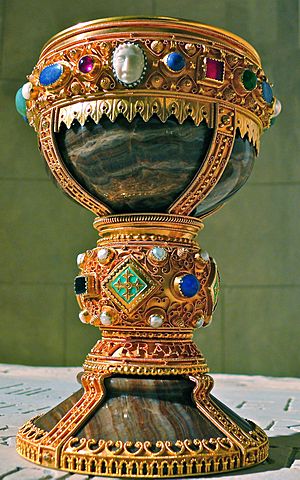
Basilica Architecture
The basilica is mostly built in the Romanesque style. However, it has had big additions in later centuries, including the Gothic style. The arches where the transept crosses show influences from Islamic art. All these different styles blend together beautifully.
One of the most famous parts of the basilica is the carved tympanum above the Puerta del Cordero (Lamb's Door). This Romanesque carving was made before 1100. It shows the story of Abraham making a sacrifice.
Royal Pantheon: A Royal Burial Place
This is also known as the Pantheon of the Kings of León. It is the burial chapel for the kings of León. It is one of the best examples of Romanesque art still existing in León. The columns have unique Visigothic capitals. These capitals are decorated with floral or historical designs. The painted murals from the 1100s are in amazing condition. They show scenes from the New Testament and also everyday country life from that time.
Basilica Museum
The museum at the basilica holds many examples of early medieval art. These include fancy chalices decorated with jewels, and items made from ivory and precious metals. The library has 300 medieval books and many old manuscripts. There is a Mozarabic Bible from 960 and a Latin version from the 600s. You can also find a text of the law code used by the Visigothic rulers of Spain from the 600s. The Chalice of Doña Urraca is one of the most important items in this museum.
Gallery
See also
 In Spanish: Basílica de San Isidoro (León) para niños
In Spanish: Basílica de San Isidoro (León) para niños


